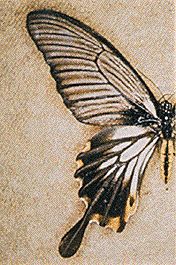Papilio memnon

Papilio memnon is a swallowtail butterfly living in the Malay Archipelago and Indonesia. The females come in a variety of morphs. The most common morphs, such as anchanes, mimic natural models which are unpalatable to birds.
The butterfly Papilio memnon provides a good example of linkage disequilibrium:
Unlike the camouflage polymorphism in the peppered moth, each of the different morphs is thought to be controlled by a multi-locus genotype.
The loci in question are so tightly linked that rare recombinants practically never arise - this explains why the different multi-locus genotypes appear, when crossed, to segregate like single locus genotypes. A set of genes so tightly linked that they behave like a single locus has been termed a supergene. However, a sufficiently large number of crosses should be able to break one of the supergenes into different combinations.
In the P. memnon there appear to be at least five loci in the mimicry supergene: T, W, F, E and B.
The five loci control respectively presence or absence of
• tail,
• hindwing patterns,
• forewing pattern,
• epaulette color, and
• body color.
The rare anura morph (pictured opposite) is thought to be a recombinant between the T- locus and the other four.
An animation illustrates the distribution of different forms of Papilio memnon.
Why are the mimetic loci tightly linked in P. memnon ?
| Next |



